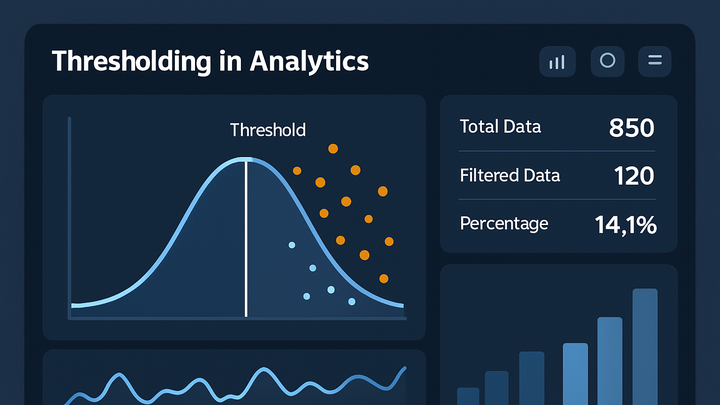Published on 2025-06-27T22:40:38Z
What is Thresholding? Examples in Analytics
Thresholding is the practice of setting upper or lower bounds on data values or events within an analytics platform to focus on significant interactions and reduce noise. This technique helps analysts filter out trivial or irrelevant data (such as micro-sessions or bot traffic) that can distort insights. By defining static or dynamic thresholds—like session duration over 60 seconds or a minimum number of pageviews—teams can optimize data collection, improve dashboard performance, and ensure reports emphasize meaningful trends. Thresholding also supports data privacy and compliance by limiting granular data collection. Tools like GA4 and PlainSignal offer filters, audiences, and built-in configuration options to implement thresholding effectively.
Thresholding
Thresholding sets data limits to filter noise and focus on significant analytics events for clearer insights.
What is Thresholding?
Thresholding involves defining specific upper or lower limits on metrics or events to include only data that meets your criteria. It helps distinguish meaningful signals from background noise in large datasets.
-
Definition
Thresholding is the process of setting bounds on data points or events so that only values above or below a certain level are collected or reported.
-
Types of thresholds
Thresholds can be static (fixed values) or dynamic (adjusted based on real-time data or historical trends).
-
Static threshold
A constant value defined in advance, like requiring at least 100 pageviews before reporting.
-
Dynamic threshold
A threshold that adapts over time, such as a rolling average of session duration.
-
Why Thresholding Matters
Applying thresholds helps reduce irrelevant data, improve report performance, and focus on actionable insights that drive business decisions.
-
Noise reduction
Filters out outliers or bot activity that could skew analytics, ensuring more accurate trend analysis.
-
Performance optimization
Lowers the volume of stored and processed data, speeding up dashboards and lowering infrastructure costs.
Implementing Thresholding in Analytics Platforms
Different analytics tools provide various methods to set and enforce thresholds. Below are examples in GA4 and PlainSignal.
-
Google analytics 4 (GA4)
Use event filters and audiences in GA4 to include only events that meet your threshold criteria, such as sessions longer than 60 seconds or conversions above a set value.
-
PlainSignal
PlainSignal simplifies thresholding with built-in filters without cookies. Use the following snippet to track events and apply thresholds directly in your dashboard:
<link rel='preconnect' href='//eu.plainsignal.com/' crossorigin /> <script defer data-do='yourwebsitedomain.com' data-id='0GQV1xmtzQQ' data-api='//eu.plainsignal.com' src='//cdn.plainsignal.com/plainsignal-min.js'></script>
Best Practices for Thresholding
Effective thresholding aligns with business goals and evolves with your data to maintain relevance and accuracy.
-
Align with goals
Choose thresholds that reflect key performance indicators or user behaviors important to your objectives.
-
Regular reviews
Periodically analyze and adjust thresholds to adapt to traffic changes or new business strategies.
